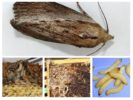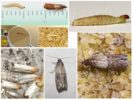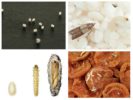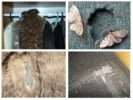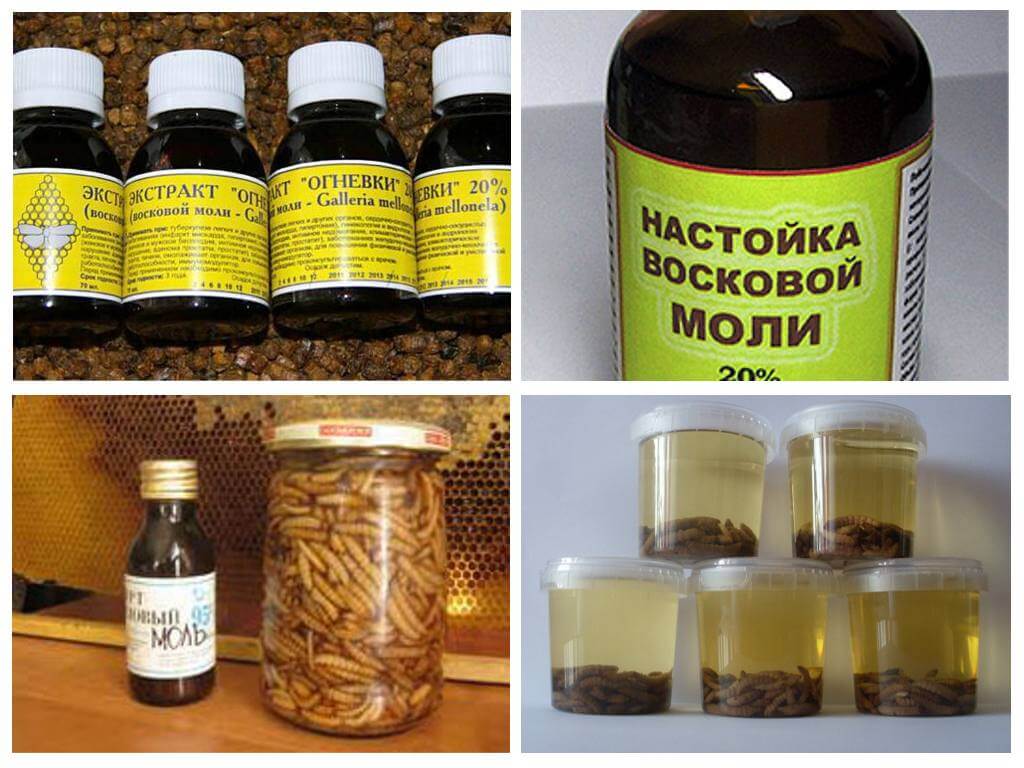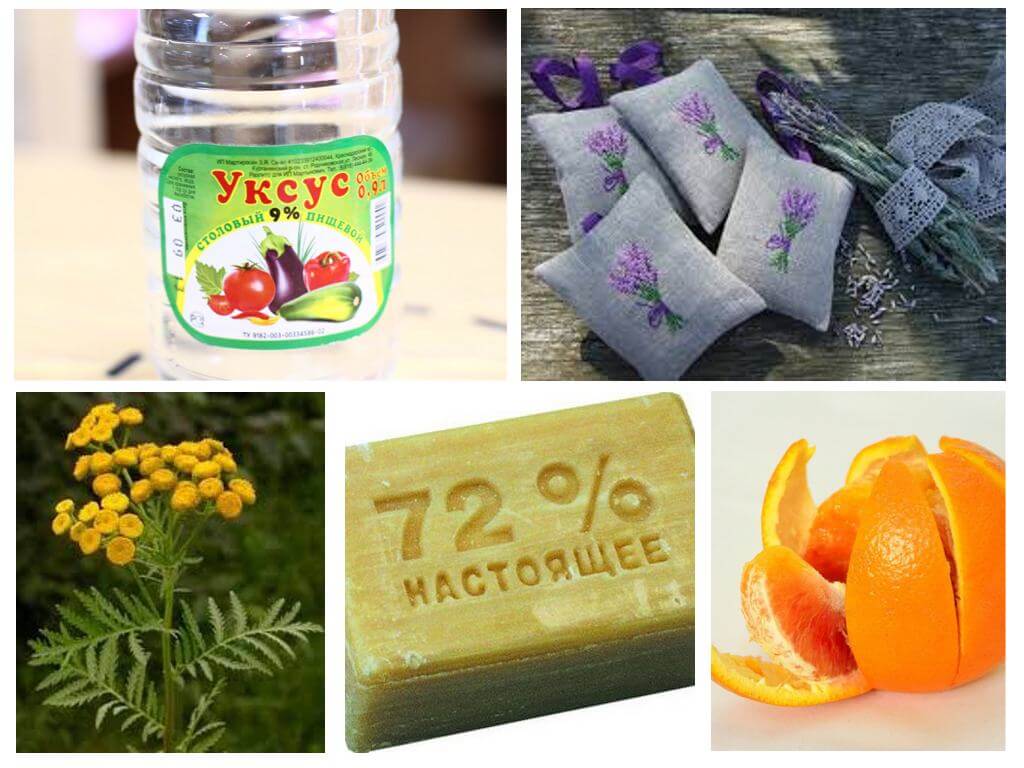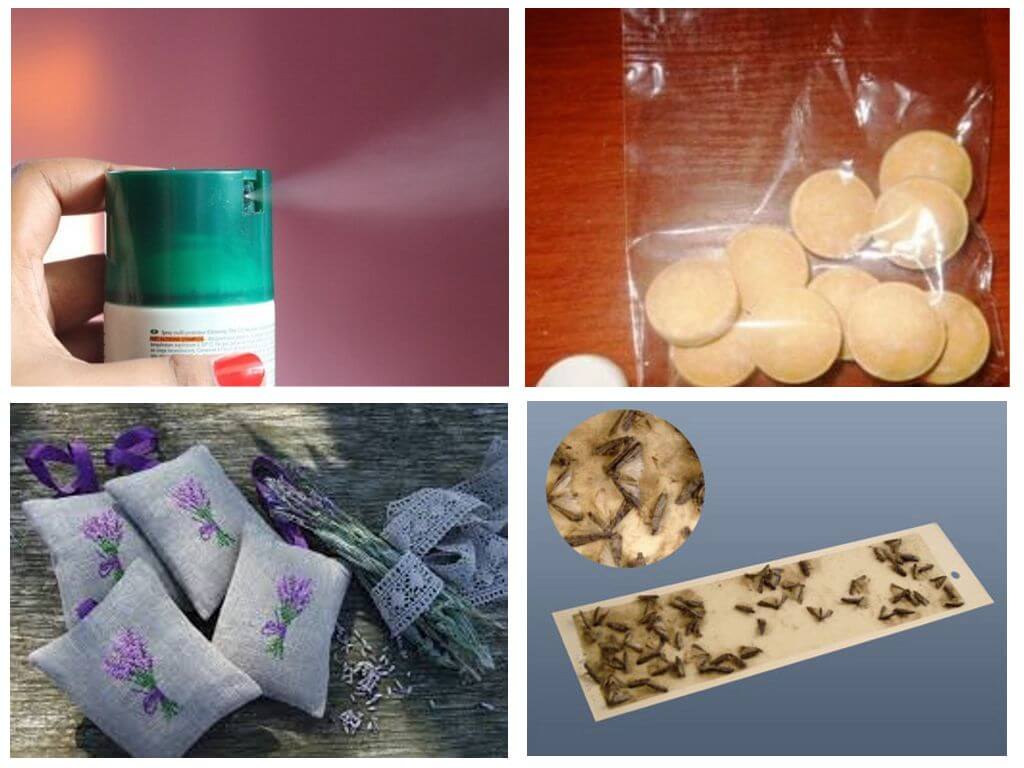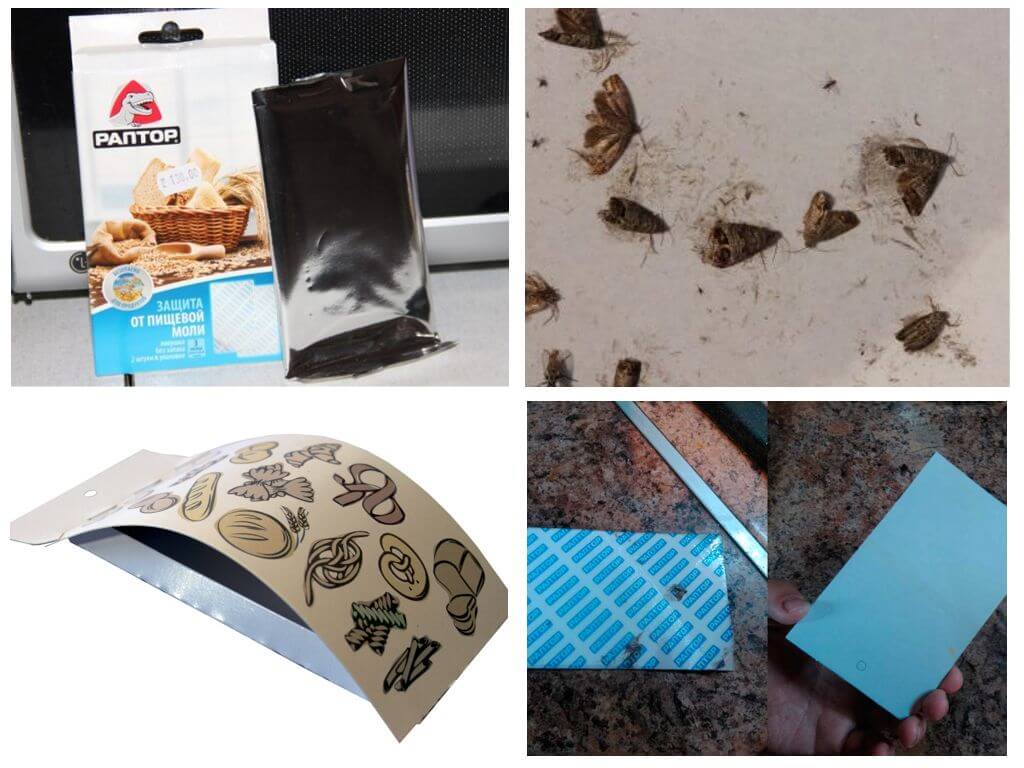- Wax moth
- Food moth
- Clothes moth
- Larvae and moth eggs
- Moth in the house
When we say that “the moth spoiled all things,” referring to both clothes and food, we are not quite right. All this spoils is not an adult, but only moth larvae, since moth butterflies have no probosciswith which she could do this. An adult lives at the expense of those stocks that the larva managed to make. And so, in order to “hold out” longer in its adult state, the caterpillar eats everything around, which corresponds to its ideas about proper nutrition.
Every housewife knows that not only clothes suffer from the pest. But not everyone understands that hundreds of species of this insect can live in a house, each of which eats one kind of food. Larvae of the moth, depending on the species, eat fabrics, furs, feathers, bread, flour, nuts, cereals, dried fruits, pet food and more.
Only a professional is able to distinguish “in person” the larvae of moths of different species, since they are all very similar to each other.
The benefits of pests
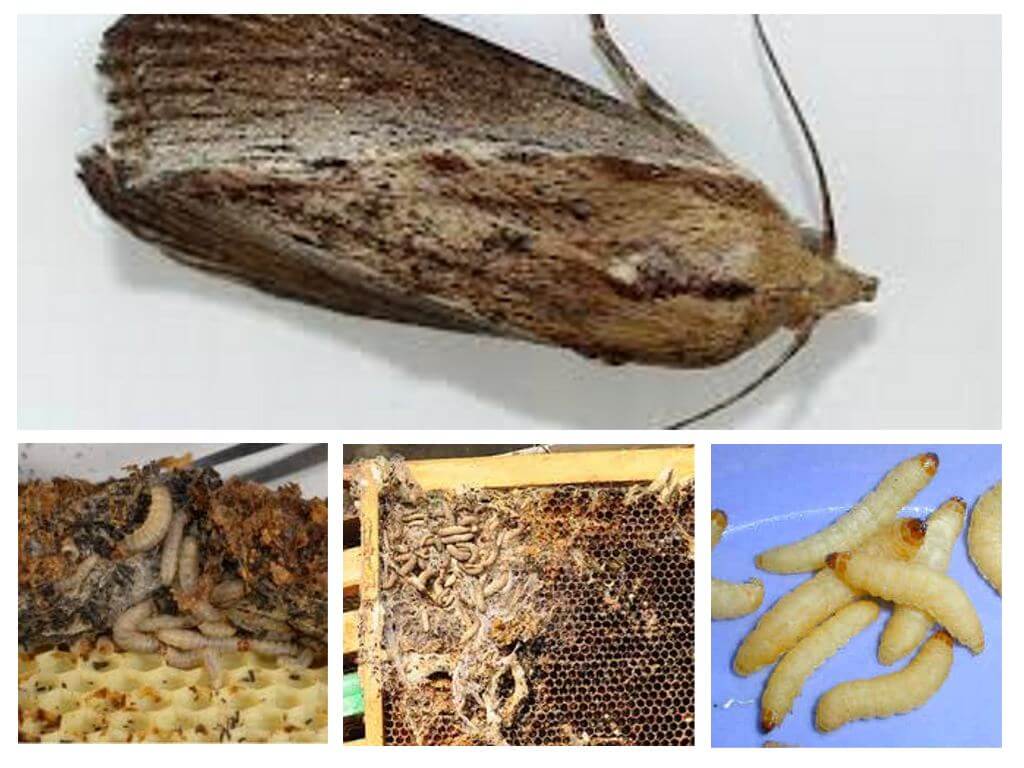
Curiously, the moth larva can be beneficial. So, for the treatment of tuberculosis, a hive pest is used - wax moth. Caterpillars of this species are used as the basis for tinctures and wax moth extracts. The enzymes used by the insect to break down wax act similarly on tuberculosis bacillus. After exposure to the enzyme, the disease is more likely to be treated with antibiotics.
Other species, like larvae of burdock moth, are used as bait for ice and other species, fishing.
Features of different types
In the house, moth larvae are usually divided into clothes and food. It is easy to understand that the first of them feed on haberdashery, and the second on grocery. The moth larvae in the photo and at the “personal” meeting seem to be exactly the same, but there are differences between them.
Food moth
It is not difficult to recognize the larvae of a moth food: these are small worms, white or almost transparent. The head is clearly marked, 2 pairs of legs located on the first segments of the body, 4 pairs on the abdomen. The length of these worms does not exceed 2 cm. The volume of the caterpillar directly depends on the type of feed that it prefers. If it is fatty food, the faces of the food moth will be thick. If the caterpillar sat on the "diet", it will be very thin.
On a note!
Caterpillars of food moth eat only food. Damage to furniture or things is not on her conscience. Therefore, those housewives who saw the larvae in flour can be calm about the contents of the cabinets. But preventive measures should be carried out regularly, since there is no guarantee that another type of moth, eating fur coats, does not live in the house.

Those foods that are easy to find food moth:
- Flour;
- Cereals;
- Dried fruits;
- Nuts
- Pasta;
- Sunflower seeds;
- Candy;
- Cookies.
Moth and its larvae, eating foods, prefer carbohydrate-rich foods. The jaws of a moth caterpillar can gnaw even hard shells of grains. You can find out that the pest has settled in the cabinet by the following signs:
- Cobweb in the croup;
- Tunnels filled with larvae;
- Lumps in fine cereals and flour;
- Abandoned skins.
Interesting!
If you break the shell of the cocoon or lumps of grains, you can see how the larva of a moth curled up in a cocoon looks like. Caterpillars food moth hardly move, often they are found only in the finished dish.
Larvae can be found everywhere where there are favorable conditions for development and suitable food. This insect has spread all over the world, where it successfully devours products on various scales: in warehouses, in houses, in shops, in grain processing enterprises.
Clothes moth
The larvae of the moth look like food caterpillars, but it is impossible to find them in the kitchen. Only keratin-containing items are suitable for food. It can be fluff, hair, wool and feathers. In our homes, these insects feed on:
- Woolen clothes;
- Fur coats;
- Carpets
- Felt products;
- Natural edge on the collars;
- Feather or down pillows.
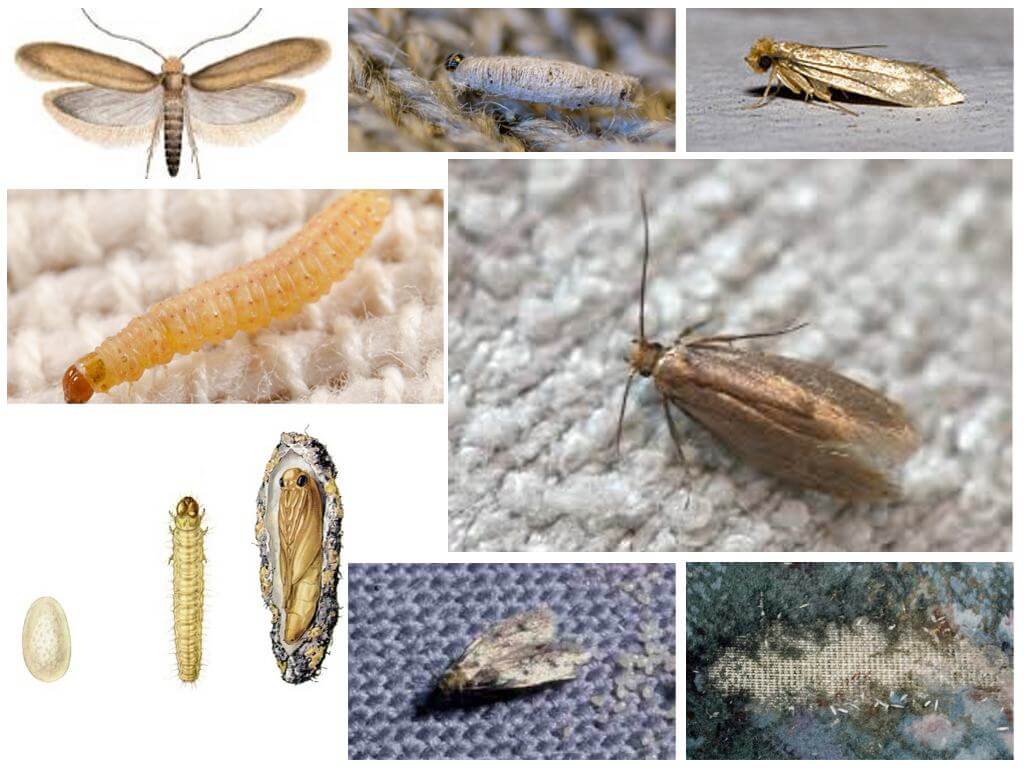
Depending on where the caterpillars “graze”, furniture, wool, fur coats or larvae of carpet moths differ. Like food brethren, they build houses for themselves from what they live in: fluff, wool, small hairs. It is very difficult to notice the hidden larva, it can be done by indirect signs:
- Holes in clothes;
- "Bald spots" in furs;
- The spools are cocoons;
- Strokes on carpets or upholstery.
Important!
Even shoes can be eaten by moth larvae. Not all, but made of fur or felt. The insect devours felt boots and insoles from felt.
A clothes moth is no less common than a food moth.
Reproduction and development
The insect has several stages of development; in the larval stage, several molts pass before pupation. The period that the insect spends in the larval stage depends on the environmental conditions and the particular type of insect. It is known that the caterpillar of a food moth develops faster than a clothes one, because in their diet there are more substances useful for caterpillars. Such a larva is capable of developing in just 1-1.5 months. And the warmer in the house, the faster the cycle will end. Under the same conditions, a clothes moth takes at least 2-3 months to mature completely.
Larvae of domestic moths are preferred to be pupulated in dark secluded places. Rare species for this purpose creep closer to the light. Pupa can reach 6-9 mm. The outer sections of the “skin” of the caterpillars harden and darken. Inside such a shell, a transformation into a butterfly occurs.
After 1-2 weeks, a completely adult insect is selected from the cocoon, living only up to 3 weeks. In this short period, she must meet a partner, find food suitable for the offspring and lay eggs.
The laid eggs are very small, even imperceptible without additional devices. Their length is not more than half a millimeter. Most often these are white oval grains. Under suitable conditions, after only 7 days, a transparent small caterpillar emerges from them. Eating and growing up, it darkens.
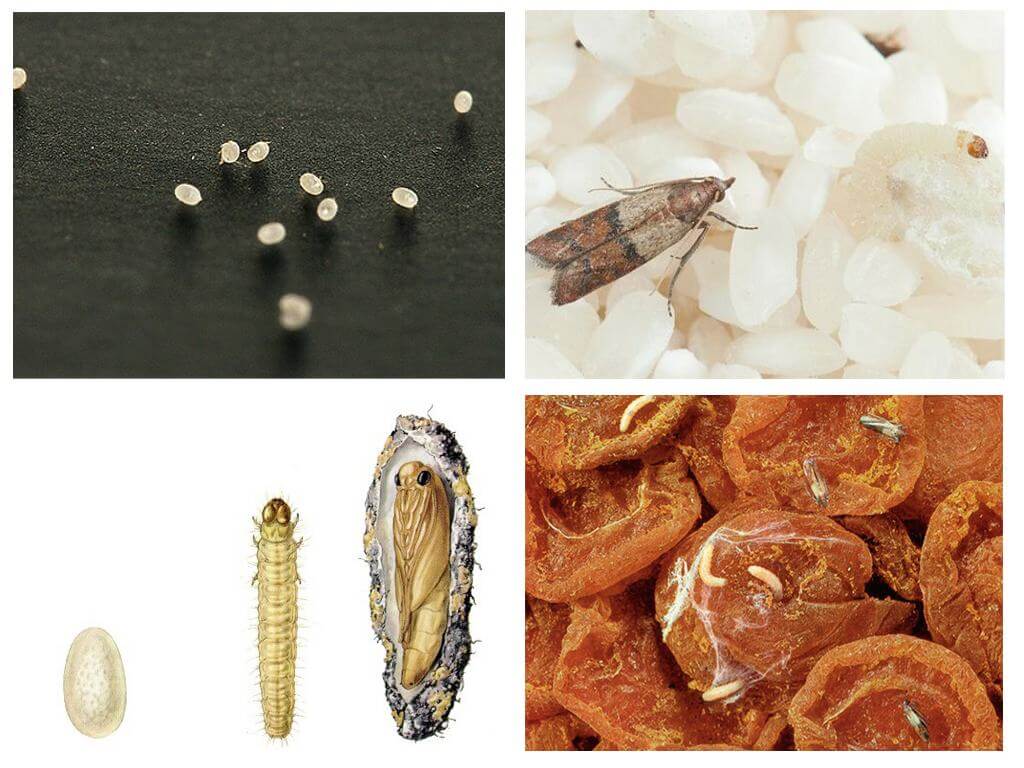
Lifestyle
The development period of the tracks depends on the environmental conditions. A clothes moth prefers a temperature of 23-25 degrees. Under these conditions, it will take 3 months for development. If the temperature rises to 30 degrees, this period will be reduced to 2 months. If you maintain a temperature of 13 degrees in the apartment, the caterpillar will be forced to eke out its existence for 6 months 10 days.
If the temperature drops below 13 or exceeds 30, the tracks will die.
On a note!
The movement of the pest between human dwellings occurs with the help of man. Most likely, the caterpillars are transported, because the butterflies are practically unable to fly. Larvae are brought into the house with clothes, carpets, food.
Larvae feeding
The way the moth larvae look, does not affect food moth: although they are very small, they can eat a lot. In nature, moth eats feathers of birds in nests, animal hair, crops, berries, nuts, vegetables.
To get into human housing for a moth is like breaking a jackpot for a person, since the conditions here are incomparable with the natural ones: a comfortable temperature is constantly maintained, there is always a lot of food. Therefore, on the shelves of our cabinets you can find much more larvae than they live in natural conditions.
Among the pests there are those who are not interested in clothing, furniture and products. Among these insects are wax moth spoiling honeycombs. And some species that settle in anthills destroy the larvae of the owners of the dwellings.
Very often, insect species change their “specialization." This does not mean that the larvae of food moths will be bitten by a cabinet, but after ruining all the rice, it is quite capable of switching to flour or cookies. So the thing moth, the “charter” to chew on a fur coat, is capable of switching to a carpet or to a shelf with woolen things. In especially difficult times, the moth is even able to hold out on semi-synthetic clothing. It is the omnivorous larvae that cause their high survival. In order to preserve things and products, it is necessary to start combating the emerging pest as early as possible.
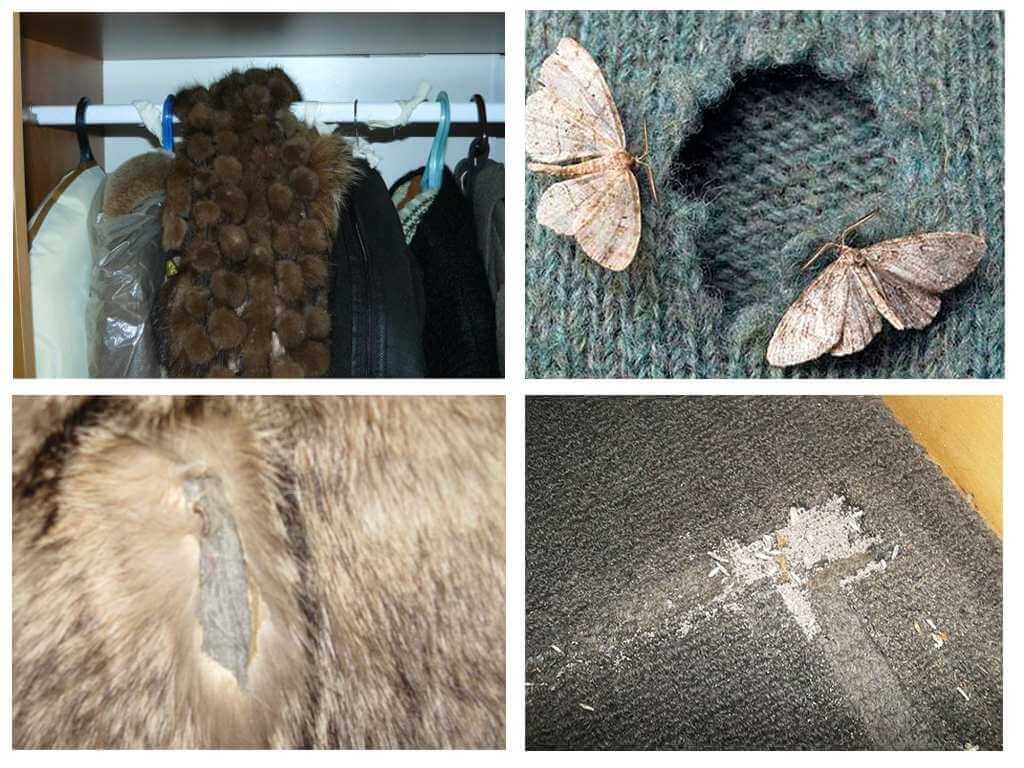
The main enemy of things
Any natural tissue can become food of larvae of a moth. The older the thing, the more chances she likes moths, because such fibers are easier to break with small jaws. One caterpillar eats relatively little, outwardly you may not even notice damage. But remembering that the butterfly lays at least 100 eggs, one can imagine what damage the hordes of these larvae do.
Fight
Although the larva does not look too dangerous, moth control it is necessary to start immediately, as soon as the first signs of its appearance have been noticed. Methods of dealing with it are quite simple and effective.
Wardrobe and furniture moths can be removed by processing furniture, carpets and clothing with chemicals sold in any hardware stores. After processing and maintaining a certain time, things must be washed and furniture thoroughly washed.
The larvae hold tightly to the clothes, so even with ordinary shaking, they begin to fall. If things hang in the sun or frost, the tracks will die. Fight moth larvae as follows:
- Shake all the clothes.
- Warm up in the sun or wash at a temperature of 50 degrees.
- Spray insecticides on clothing and closets.
- Use flavored repellents to prevent re-colonization of insects.
Fighting food moths is somewhat more difficult. It is impossible to poison the larvae with chemistry, since the poison will fall into the products. Such a set of measures should be done:
- Throw away all bags and packaging inside which the tracks are found;
- Kill all visible butterflies;
- To treat places of food storage with aerosols from flying insects;
- Wash cabinets with soapy water;
- Do not purchase a large stock of products.
Prevention
Avoiding the infection of things and products with moths is easier than getting rid of it. To do this, wash all purchased items and carefully check all products. In kitchen and wardrobes, the peel of lemons and oranges should be laid out, hang twigs of wormwood, sage, and a string.
